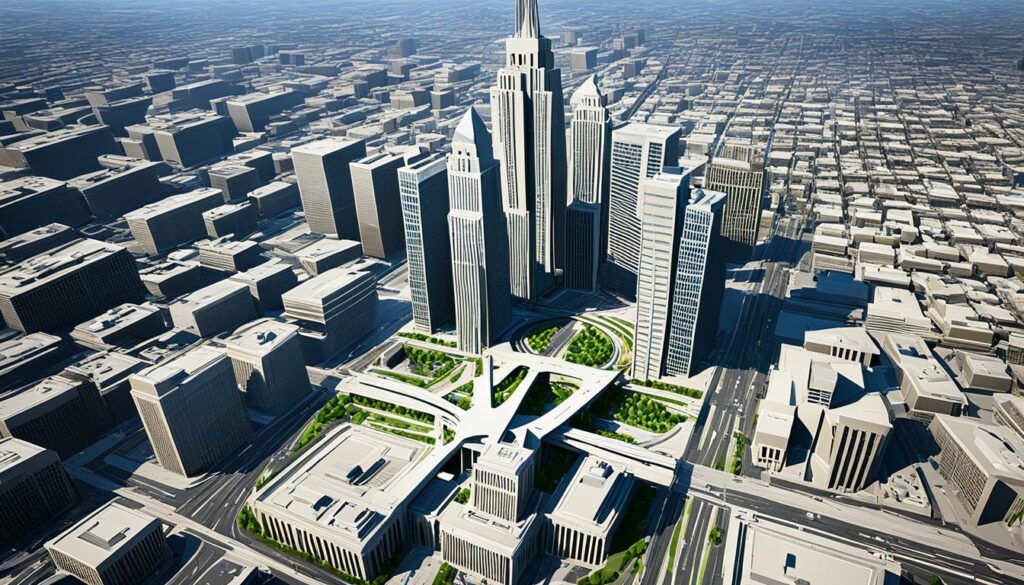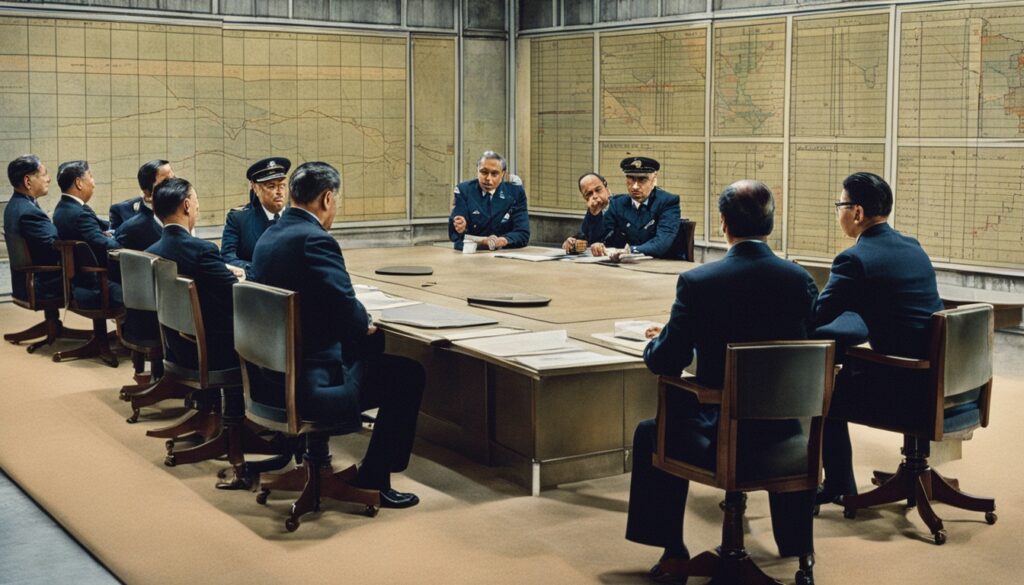“As an Amazon Associate I earn from qualifying purchases.”
Imagine living in a world where everything the economy does is controlled by the government. From what goods are made to the prices you pay, the government decides it all. This is how a socialist command economy works, with planning by the center taking the lead. You might find yourself quite curious and maybe a bit unsure as you learn more about this system.
Here, the government owns and manages the ways things are produced. This doesn’t leave much space for private businesses to work. Instead of prices being set by market forces, the government steps in. It also decides how to use resources, like labor and raw materials, without the pull of supply and demand.
Key Takeaways
- In a socialist command economy, the central government dictates and controls various aspects of the economy, including production levels, prices, and resource allocation.
- Most industries are publicly owned, with little to no private ownership of land and capital.
- The government sets national economic priorities through multi-year plans, such as five-year plans, that outline goals for economic growth, resource allocation, and output distribution.
- Key features include centralized planning, state ownership, price controls, production quotas, and collectivization.
- While proponents argue that command economies can ensure fair distribution and employment, critics highlight issues like the lack of incentives and the information vacuum faced by central planners.
Understanding a Socialist Command Economy
In a socialist command economy, the government takes control over production. It does this through state ownership. This means all businesses are run or owned by the government. You won’t find private ownership of land or capital here. Learn more about it here.
Centralized Planning and State Ownership
The government owns and manages factories, land, and more. It decides on economic policies, such as how much to produce and what to pay workers. This is very different from how things work in free-market economies.
Economic Priorities and Multi-Year Plans
Government officials decide on what’s important for the economy. They make these decisions through plans that span several years. A good example is China’s five-year plans. These plans set goals for different industries. They might aim to reduce pollution or improve life in rural areas.
China, for example, has had many five-year plans. They’re making a new one that ends in 2025, showing how they plan for the long haul.
| Command Economy Examples | Transition to Mixed Economy |
|---|---|
| Cuba, North Korea, Former Soviet Union | China (transitioned in 1978) |
Some believe command economies can use resources better for the people’s benefit. But they also have issues. These include problems with getting people motivated and not having enough information for good planning.
How Does a Socialist Government With a Command Economy Manage Its Economy?
A socialist government uses centralized planning and state ownership to run its economy. It sets production quotas for goods and services. These quotas are goals that companies must meet.
It also controls prices, not allowing them to change naturally. The government decides on prices instead of letting the market decide.
Resources like labor, materials, and money are carefully managed. They are given to different places as the government sees fit. This is all part of a big plan to meet the country’s economic goals.

The goal is to make sure everything is fair. The focus is on helping society rather than making money.
Scandinavian countries like Sweden and Norway are known for their balance. They mix market competition with strong social programs and protections for workers.
But, some say this way of managing an economy has problems. They point out it can be hard to motivate people to work hard without rewards. Also, planning without information from the market can cause mistakes.
Three Great Economic Questions
In a command economy, the government decides the answers to three key economic questions. These questions shape how a country uses its economic policies and resource allocation. They decide what to produce, how to make it, and who gets the goods.
What Should We Produce?
The government decides what items and services are made and how much. They use production quotas to plan the output. This plan focuses on the nation’s goals more than what people actually want to buy.
How Should We Produce?
The central government controls how things are made, too. They manage factories, choose how to use resources like workers and materials. This way, the government picks how products will be created in different fields.
Who Should Get the Rewards?
In this system, the distribution of goods and who benefits is not up to the free market. The government decides who should get the results of production, making sure it fits the country’s aims. It doesn’t depend on typical supply and demand rules.
Government Control and Regulation
In a socialist command economy, the government has significant power over economic activity. It uses centralized planning and control to do this. Various regulations help the government manage the economy.
Production Levels and Quotas
The government sets production quotas for different goods and services. It tells manufacturers how much they need to produce. This process is not based on what consumers want but on what the nation needs.
Price Controls
The government doesn’t let prices change with supply and demand. It sets price controls, deciding how much things cost. This means the market doesn’t decide how resources are used.
Resource Allocation
In a state ownership system, the government controls where resources like labor and materials go. It makes sure these resources meet national economic goals. This method follows multi-year plans to guide resource allocation.
Countries like Cuba, North Korea, and the former Soviet Union are known for command economies. China, however, went from a full command to a mixed economy in 1978. Here, they started to mix in market-based strategies while still letting the government play a big role.
| Economic System | Key Characteristics |
|---|---|
| Command Economy |
|
| Mixed Economy |
|
Arguments in Favor of Command Economies
Supporters say command economies can make sure goods and services are fairly shared. This means everyone can benefit, not just those making money. They believe command economies do better than free markets in many ways.
Maximizing Social Welfare
Under this system, the economy is run for everyone’s benefit. It aims to divide resources and results fairly. This is different from letting market trends decide who gets what.
The government manages what’s made and who gets it. This way, wealth and goods can be spread out more equally. It’s a step toward less inequality.
Employment Control
Command economies keep job numbers high, whether or not there’s a strong market. The government decides where to put workers and resources. This way, almost everyone has a job and a steady pay.

Crisis Management
In times of crisis, a central system is said to respond better and faster. It can use rationing and pull resources together. This helps deal with big economic or shortage problems.
Command economies prioritize the common good over profit, aiming to maximize social welfare through government control and resource allocation.
Arguments Against Command Economies
Command economies try to make life fair and keep jobs safe. Yet, they face big problems: the incentive problem and the information vacuum for those in charge.
The Incentive Problem
In these economies, the government sets pay levels and bans making profits. This means workers and bosses can’t earn more for being better at their jobs. So, they might not work hard or come up with new ideas. This incentive problem slows down how fast the economy can grow.
The Information Vacuum
Leaders in a command system don’t know what people want without market signals. Missing these, they struggle to decide how much of each thing to make. This can cause too many or too few products, wasting resources and creating inefficiency.
Some people say command economies don’t spark innovation due to no competition, problems getting incentives right, and lack of info. They believe systems that focus on what people want and can pay for tend to do better. In such systems, the need for profit pushes businesses to get creative, which can make things run smoother.
Characteristics of a Command Economy
A command economy means the state owns big industries. It also means having centralized planning for the economy. The government decides how much to make and what to charge for goods and services.
Public Ownership of Major Industries
The government runs most big industries and assets in a command economy. They own things like factories and the land. This removes private ownership. For more about command economies, you can learn here.
Government Control of Production and Distribution
The top authorities decide how much to make and who gets what in a command economy. They tell companies how much they must produce. They also plan out where the goods go through centralized planning.

Prevalence of Monopolies
In command economies, having monopolies is common because of no competition. The government sees monopolies as needed to reach its goals. They use these large businesses to help achieve their plans.
Some examples of command economies are:
- Cuba
- North Korea
- The former Soviet Union
China changed to a more open economy in 1978. Yet, it still has big government control. China guides its development with long-term economic plans, setting goals every five years.
| Command Economy Features | Description |
|---|---|
| State Ownership | Major industries and productive assets are owned by the government. |
| Centralized Planning | Economic activities are planned and controlled by the central authorities. |
| Production Quotas | The government sets mandatory output levels for various goods and services. |
| Price Controls | Prices are fixed by the government, not determined by market forces. |
| Monopolies | Lack of competition leads to monopolies in key industries. |
Differences From a Free-Market Economy
A command economy is very different from a free-market economy. In a free market, companies decide how much to make based on what people want. This happens because prices change with supply and demand. But in a command economy, the government is in charge. It decides how much to make and what things should cost. These decisions are based on what the country needs, not just what people want.
Free markets do have some rules, but not as many as command economies. Government control is much bigger in command economies. The state owns most big businesses. This lets the government say how much to make, how to sell it, and for how much.
In a free-market economy, people own businesses and make their own choices. They aim to make money and meet the needs of customers. This system leads to competition and new ideas. It uses price changes to decide where to invest money and effort.
The fundamental difference between a command economy and a free-market economy lies in the mechanisms that shape economic outcomes. While command economies prioritize centralized control and societal objectives, free markets are propelled by the invisible hand of supply and demand, with individuals and businesses responding to consumer preferences and market incentives.
Yet, many places today use a mix of both. This is called a mixed economy. It combines the good parts of each system. It allows the government to help if the market doesn’t do something right or to help people in need.
Central Planning and Five-Year Plans
Central planning is key in command economies, seen through five-year plans. These are long-term economic policies used by countries like the Soviet Union and China. They set specific targets and strategies for different industries.
Goals and Strategies for Industries
The five-year plans define what each industry must achieve. They lay out what resources should be used and how. For example, China has undergone 14 of these plans so far, and its current one ends in 2025. These can focus on goals like cutting down on pollution, helping rural areas, or boosting key industries as seen by the government.
Participation in Government Objectives
With centralized planning, companies must match their efforts with the government’s goals. This way, economic actions are pulled together to meet national aims. Yet, some say this method doesn’t inspire hard work and can lead to not having the right info. This could cause things not to work as well and lead to shortages.
The Soviet Union’s five-year plans from 1928 to 1940 aimed to grow industry, especially under Stalin. But, this period also saw a lot of political oppression. Another big effort in these plans was bringing farms under state control, known as collectivization.
Conclusion
In a socialist government with a command economy, the central authorities have a lot of control over what happens in the economy. The government tells people how much to make, controls prices, decides who gets what, and plans everything. Some see this as a way to make sure everyone gets a fair share and has a job. But, others worry that this system doesn’t encourage hard work and the people in charge might not always know what’s best.
In the Soviet Union, for instance, Gosplan made detailed plans for the country’s economy every five to seven years. They focused on turning the country into a strong industrial power quickly. They made everyone share in the work and limited what people could have. While this helped with the Soviet Union’s growth, problems arose especially when things were not emergencies. Command economies involve a lot of government control. This is very different from market systems, where decisions come from what people want to buy.
When we look at various economic systems, it’s important to think about the trade-offs they offer. Command economies try to put the community first and organize things when there’s a big problem. But, they might stop new ideas and have trouble making what people really want. On the other hand, in free markets, there’s more room for creativity and hard work. Yet, they might not always create a fair environment or work perfectly. Understanding these benefits and challenges lets us choose economic policies that match what we care about.
FAQ
What is centralized planning in a socialist command economy?
What role does state ownership play in a socialist command economy?
How does the government manage economic priorities and plans?
What are the three fundamental economic questions addressed by the government?
How does the government control production and prices?
What are some arguments in favor of command economies?
What are some criticisms of command economies?
How do command economies differ from free-market economies?
What are five-year plans in a command economy?
“As an Amazon Associate I earn from qualifying purchases.”

